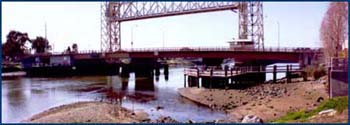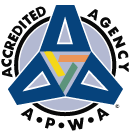Miller-Sweeney Bridge

The Miller-Sweeney Bridge at Fruitvale Avenue is a four lane single leaf bascule bridge, similar to the Bay Farm Island Bridge, which spans the Oakland Estuary for 98 feet. The Oakland Estuary is a navigable water way with access to the San Francisco Bay. The phone at the bridge tower is (510) 533-7858.
HISTORY
A bascule bridge is a a draw bridge that is counterweighted so that it may be raised or lowered easily. The original bridge was constructed in 1894 and, after a four year court battle, was turned over to the U.S. War Department and U.S. Army Engineers. This bridge and the High and Park Street bridges, were built by the U.S. Government in exchange for permission and rights-of-way to dredge the channel between San Antonio Creek and San Leandro Bay. It was constructed by Darby Langdon & Company of San Francisco at an original cost of $53,759. It was manually operated in 1902, then electrified in 1911. Originally used only for trains, cars soon became the main mode of traffic and the train tracks were removed in 1951.
The present structure was constructed by the U.S. Army Corp of Engineers and opened to the public on December 12, 1973 and received awards from the Steel Industry for engineering and design excellence. The bridge was turned over to the County in 1975 and was named Miller-Sweeney. It handles approximately 28,000 vehicles each working day. This bridge allows for 15 feet of vertical clearance, instead of the six feet offered by the new bridge.
In 1951, a new 215 foot long vertical lift bridge just for trains was built next to the Miller-Sweeney Bridge by the Corps of Engineers.
OPENING
Miller-Sweeney Bridge shall open on signal; except that, from 8:00 a.m. to 9:00 a.m. and 4:30 p.m. to 6:30 p.m. Monday through Friday except federal holidays, the draws need not be open for the passage of vessels. However, the draws shall open for the above closed periods for vessels which must, for reasons of safety, move on a tide or slack water, if at least two hours notice is given. The draws shall open as soon as possible for commercial vessels engaged in rescue or emergency salvage operations.
The bridge is manned by an alternating four person crew. The bridge is equipped with a Marine Radio, the preferred working channel in the San Francisco Bay Area is Channel 9 and Channel 16 is used for hailing and distress. Vessels can also gain a bridge opening by using a horn. The signal is a long blast followed by a short blast. Signal flags and lights may also be used if Coast Guard approved methods are followed. For more information on drawbridge operations, see "California Drawbridge Regulations" by the Coast Guard.
Although draw bridges are required to open for vessel traffic even if that means that vehicular traffic must wait, there are some exceptions to this rule.
Vessel and Vehicle Traffic
- 1,588 Opening per year
- 1,750 Total Vessels
- 615 Barges
- Westbound 8,750 vehicles per day
- Eastbound 6,400 vehicles per day
- Total Vehicle Traffic per day 15,300
- Busiest Hour Westbound 5 to 6 pm 945 vehicles
- Busiest Hour Southbound 7:30 to 8:30 am 633 vehicles
- Slowest Hour Westbound 3 to 4 am 13 vehicles
- Slowest Hour Eastbound 4 to 5 am 17 vehicles
WORKINGS OF THE BRIDGE
Miller-Sweeney is a single leaf bascule bridge and was built by the Army Corp of Engineers. Miller-Sweeney is our fastest bridge, after securing the bridge for an opening it takes 66 seconds to raise the bridge to a height of 79 degrees, a full opening. Power is supplied by two 75 hp electric motors. These motors operate in tandem for a normal opening. However, each motor can operate the bridge on its own if necessary. The backup emergency motor is a 5 HP motor. Using the emergency drive it takes almost 20 minutes to raise the bridge to a full height.
Main power to Miller-Sweeney is supplied by the City of Alameda Bureau of Electricity and can run the bridge under normal operating conditions. An auxiliary operating panel is located on the Alameda Side of the bridge and is also powered by the Bureau of Electricity. The auxiliary power from our portable 50KW generator can only run the bridge using the emergency drive system, which is very slow.
When Miller-Sweeney was damaged by a vessel accident (a barge weighing 4,000 tons) the emergency drive is what kept the waterway open to vessel traffic as the main drive system would have damaged the bridge further if it was engaged.
The bridge has two brake systems that stop it. The main brake is the Service Brake, it stops the bridge at all positions whether its going up or down. The secondary brake system is the Set Brake. The Set Brake is not used in normal operating conditions. It is only used as a backup or a set brake if the bridge will be in one position for an extended period of time.
The brakes are Hydraulic-Thruster type systems, the Service Brake has a stopping force of 1000 ft/lbs. of torque. The Set Brakes have a stopping force of 5880 ft/lbs. of torque.
Before you operate the bridge's four gates and two cable barrier systems, stop traffic and pedestrians. The cable barrier system is a hydraulic system powered by a 7.5 hp motor. The barrier system on Miller-Sweeney comes out of a pit in the roadway which is different than the overhead steel structure on the other bridges.
Miller-Sweeney is the newest vehicle bridge that spans the area and it has had its share of bad luck. In 1989 the Loma Prieta Earthquake caused damage to the bridge and it was shut to all vessel traffic until repaired. In 1991 another mishap occurred when a fully loaded sand barge hit the movable span and caused extensive damage. The bridge was closed to vehicles for months and cost almost a half million dollars to repair. Since the bridge accident, Miller-Sweeny had run flawlessly and without any mishaps.
Miller Sweeney has no overhead steel structure like the Park and High Street bridges so it is recommend that trucks with high loads use this bridge. There have been many accidents on the other bridges involving trucks with high loads.
BRIDGE STATISTICS
- Vertical Clearance MLLW (Low Tide) 21 Feet
- Vertical Clearance MHHW (High Tide) 15 Feet
- Vessel Channel Clearance 96 Feet
- Bridge Height Restriction for Vehicles None
- Bridge Length 215 Feet
- Width of Roadway 52 Feet
- Width of Traffic lanes 13 Feet
- Pedestrian Sidewalks 6 Feet 1 Inc

